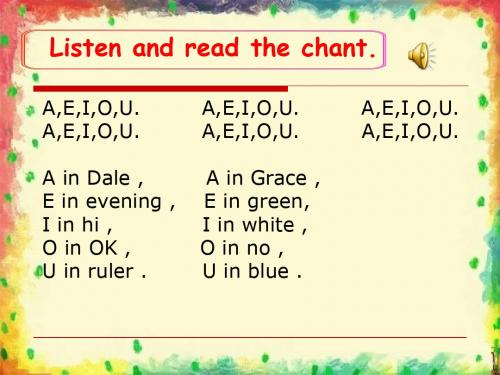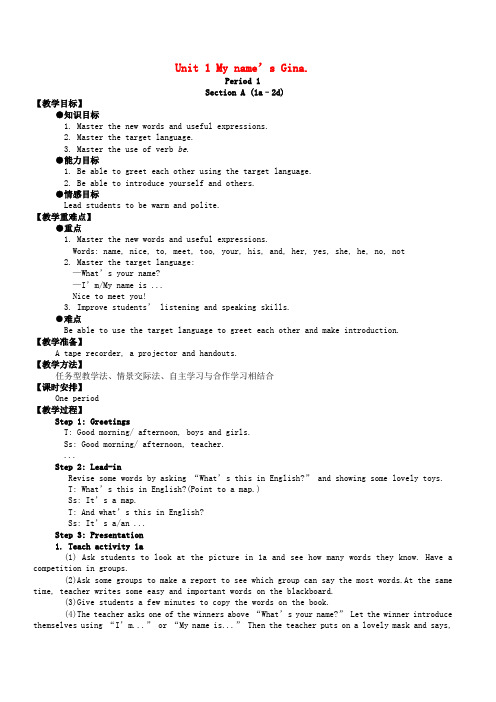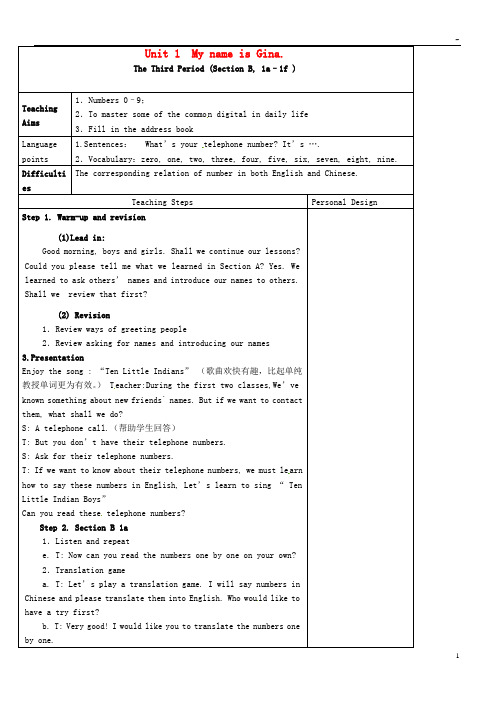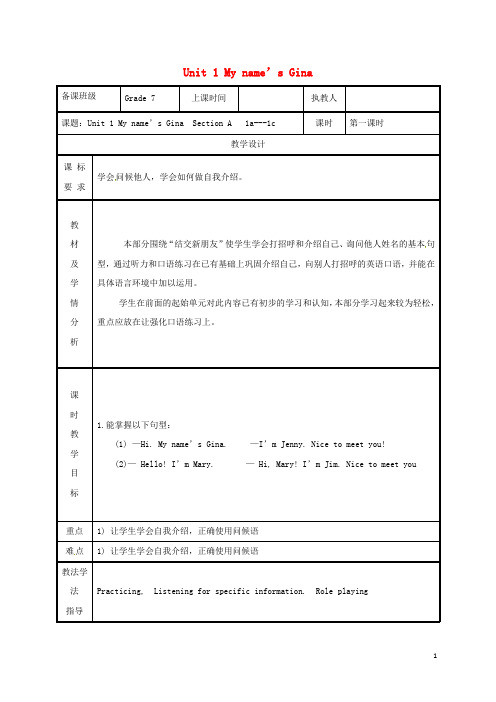2019七年级上英语第一节课
- 格式:ppt
- 大小:30.06 MB
- 文档页数:35


Unit 1 My name’s Gina.Period 1Section A (1a–2d)【教学目标】●知识目标1. Master the new words and useful expressions.2. Master the target language.3. Master the use of verb be.●能力目标1. Be able to greet each other using the target language.2. Be able to introduce yourself and others.●情感目标Lead students to be warm and polite.【教学重难点】●重点1. Master the new words and useful expressions.Words: name, nice, to, meet, too, your, his, and, her, yes, she, he, no, not2. Master the target language:—What’s your name?—I’m/My name is ...Nice to meet you!3. Improve students’ listening and speaking skills.●难点Be able to use the target language to greet each other and make introduction.【教学准备】A tape recorder, a projector and handouts.【教学方法】任务型教学法、情景交际法、自主学习与合作学习相结合【课时安排】One period【教学过程】Step 1: GreetingsT: Good morning/ afternoon, boys and girls.Ss: Good morning/ afternoon, teacher....Step 2: Lead-inRevise some words by asking “What’s this in English?” and showing some lovely toys.T: What’s this in English?(Point to a map.)Ss: It’s a map.T: And what’s thi s in English?Ss: It’s a/an ...Step 3: Presentation1. Teach activity 1a(1) Ask students to look at the picture in 1a and see how many words they know. Have a competition in groups.(2)Ask some groups to make a report to see which group can say the most words.At the same time, teacher writes some easy and important words on the blackboard.(3)Give students a few minutes to copy the words on the book.(4)The teacher asks one of the winners above “What’s your name?” Let the winner introduce themselves using “I’m...” or “My name is...” Then the teacher puts on a lovely mask and says,“Oh, I’m... Nice to meet you...” Help students to answer with “Nice to meet you, too.”(5) Write down the target language on the blackboard. Target language:—What’s your name?—I’m/ My name is ...(6) Ask the students to read the conversation in the picture together. Explain some language points.2. Teach activity 1b(1) Ask students to look at 1b and ask some pairs to read the conversations.(2) Play the recording for the first time. Students only listen and get the main idea.(3) Play the recording for the second time. Ask students to write answers by themselves.(4) Invite some students to check the answers. Then play the recording for the third time. Havestudents listen and repeat, pay attention to the pronunciation and intonation.3. Teach activity 1c(1) Invite two students to practice the sample conversation in 1b in pairs.(2) Ask students to make new conversations in pairs. Move around the classroom to check the progress and give some help if necessary.(3) Invite some pairs to act out their conversations.Step 4: Practice1. Teach activities 2a & 2b(1) Go through the instruction in 2a with the class.(2) Look at the pictures to predict who they are and where they are.(3) Play the recording for the first time. Let students check the questions they hear, then checkthe answers.(4) Go through the instruction in 2b with the class.(5) Read the English names in 2b. Help students read the English names correctly in 2b and tell students to only listen to the names.(6) Play the recording for the second time. Ask students to write letters in the blanks in 2a.Then check the answers.(7) Play the recording for the third time. And let students listen and repeat.2. Teach activity 2c(1) Ask the students to read through the conversations in the boxes in pairs.(2) Give them three minutes to practice reading it.As students work, walk around the room, offering help if necessary. Correct pronunciation mistakes if any.(3) Ask several pairs to act out their conversations.Step 5: ConsolidationTeach activity 2d1. Ask students to read the conversation by themselves to get the main idea. Try to answer these questions:①How many people are there in the conversation?②Who are t hey?2. Lead students to read the conversation sentence by sentence, and explain some language points at the same time.3. Play the recording, and ask students to listen and repeat. Then ask them to role-play the conversation in pairs. Move around the classroom to check the progress.4. Invite several pairs to role-play the conversation for the whole class.【课堂小结】In this period, we’ve learned how to introduce ourselves and other people. And we’ve alsolearned some expressions and language points for greeting.【课后作业】1. Review the new words and useful expressions in this period.2. Practice the conversation in 2d in pairs and recite it.3. Finish the exercises in the workbook.4. Preview the next period.。


My name’s Gina
学设计
课标
本部分继续学习巩固如何做自我介绍及问候他人,通过听说练习和语言实践让学生
内容仍贴近学生的生
his her name is
Yes, she/he is. / No, she/he i sn
会运用所学的句型询问第三者的姓名。
1. 阅读指导:老师总结已学过认识新朋友的两类句型。
2. 学生阅读Grammar Focus中的句子,然后做填空练习。
你的名字叫什么?_______ your _______?
我的名字叫艾伦。
_____ _______ Alan.
3. 注意以下几种缩略的表达法:what’s = what is, name’s = name is, I’m = I am,he’s = he is, she’s = she is
4. 学生识记后,做填空练习来进行巩固。
5. 老师对人称代词及形容词性物主代词的简单用法进行小结。
6.学生复习理解掌握所学的知识并做巩固巩固练习。
1.Have Ss do the exercise in 3a first.
2.Check the answ ers
the dialogues.
? ame; Are; No; I。


Unit 1 My name’s Gina.Period 2Section A (Grammar Focus–3c)【教学目标】●知识目标Consolidate the target language learned in the last period.●能力目标1. Be able to do self-introduction and introduce others using the target language.2. Develop students’ listening skills and communicative competence.●情感目标Try to improve students’ communicative ability.【教学重难点】●重点1. Consolidate the target language learned in the last period.—What’s your/ his/ her name?—My/ His/ Her name’s .../I’m /He’s/ She’s...2. Be able to do self-introduction and introduce others using the target language.●难点1. Improve students’ listening and speaking skills.2. The usage of target language.【教学准备】A projector, handouts.【教学方法】任务型教学法、情景交际法、自主学习与合作学习相结合【课时安排】One period【教学过程】Step 1: GreetingsT: Good morning/ afternoon, boys and girls.Ss: Good morning/ afternoon, teacher.T: My name is ×××, I’m your English teacher. What’s your name?(point to a student) S: My name is ...T: Nice to meet you!S: Nice to meet you, too!...Step 2: Lead-inReview how to ask other students' name.T: What’s your name?S1: I’m Xu Dong./My name is… Nice to meet you.T: Nice to meet you, too. And what’s his/her name?S1: His/Her name is…T: Are you…?S2: Yes, I am. / No, I'm not.T: Is she/he…?S2: Yes, he/she is./ No, he/she isn't.Step 3: Presentation1. Teach Grammar FocusT:What did you learn in the last class? Who can volunteer to tell us?S1:Me. We’ve learned how to introduce ourselves.S2:We’ve learned the use of verb be.S3:We’ve learned the possessive pronounces.T:Great! Today we’ll consolidate what we’ve learned in the last class.(1) Ask students to open their book, and turn to Page 3. Read through the sentences in the box.(2) Ask students to write down their answers to the questions, and substitute the names of the names of students in the box.(3) Leave students several minutes to do the task.(4) Collect their answers. Correct mistakes if there is any.(5) Ask students to read the short forms in the box. Pay attention to the pronunciation.2. Teach activity 3a(1) Look at 3a. Tell Ss to put the words in order to make conversations. Pay attention tothe right sentence structure. Ss work with their partners. Try to make conversations with the given words.(2) Check the answers. Encourage some pairs to act out the dialogue. See if their dialogues are right.(3) Ss read the dialogue aloud after the teacher. Then try to practice the dialogues with their partners.(4) Let some pairs to act out the dialogue in front of the class.Step 4: Practice1. Teach activities 3b(1) Look at 3b. Tell Ss to complete conversation. Pay attention to the right sentence structure.Ss work with their partners. Try to make conversation.(2) Check the answers. Encourage some pairs to act out the conversations. See if their answers are right.(3) Ss read the conversations aloud after the teacher. Then try to practice the conversations with their partners.(4) Let some pairs to act out the conversations in front of the class.2. Teach activity 3c(1) Now, each of you has an English name. So we have learnt many names about boys and girls.Do you know how many foreign names? Let's do a "Name game".Competition: list names as many as possible, see which group gets the most names.(2) Divide the Ss into groups of six or more. Each group has four or six students.(3) Tell Ss how to play the game. Make a model for the Ss.S1: My name is Jenny.S2: Her name is Jenny. My name is Tony.S3: Her name is Jenny. His name is Tony…My name is June.S4: …(4) Ss play the game in their groups first. Then have a competition. See which group is the best.Step 5: ConsolidationSum up the possessive pronouns “my, your, his, her...”.Do exercises:1. What’s (你的) name?2. (我的) name is Jenny.= Jenny.3. What’s (他的) name?4. (他的) name is Tony.5. What’s (她的) name?6. (她的) name is Gina.Invite volunteers to present the answers.Answers:1.your 2. My; I’m 3.his 4.His 5.her 6.Her【课堂小结】In this period, we’ve consolidated what we’ve learned in the last period through some practice and games.【课后作业】1. Read the sentences in Grammar Focus.2. Make some conversations by yourself.。